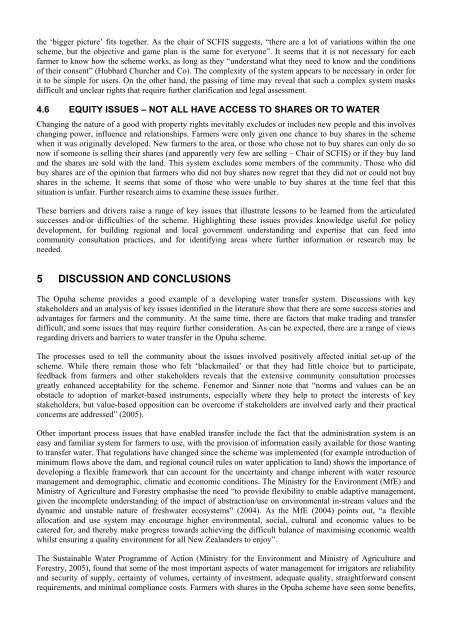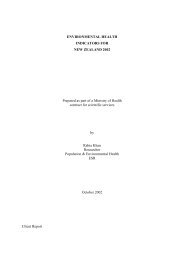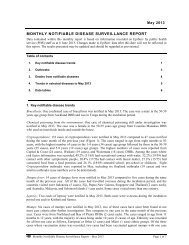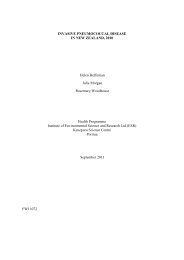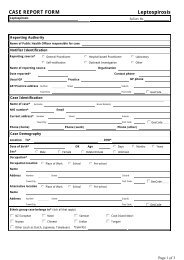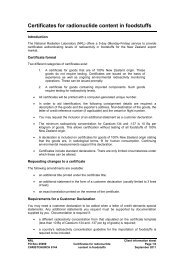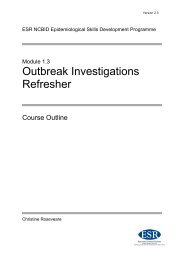the ‘bigger picture’ fits together. As the chair of SCFIS suggests, “there are a lot of variations with<strong>in</strong> the onescheme, but the objective and game plan is the same for everyone”. It seems that it is not necessary for eachfarmer to know how the scheme works, as long as they “understand what they need to know and the conditionsof their consent” (Hubbard Churcher and Co). The complexity of the system appears to be necessary <strong>in</strong> order forit to be simple for users. On the other hand, the pass<strong>in</strong>g of time may reveal that such a complex system masksdifficult and unclear rights that require further clarification and legal assessment.4.6 EQUITY ISSUES – NOT ALL HAVE ACCESS TO SHARES OR TO WATERChang<strong>in</strong>g the nature of a good with property rights <strong>in</strong>evitably excludes or <strong>in</strong>cludes new people and this <strong>in</strong>volveschang<strong>in</strong>g power, <strong>in</strong>fluence and relationships. Farmers were only given one chance to buy shares <strong>in</strong> the schemewhen it was orig<strong>in</strong>ally developed. <strong>New</strong> farmers to the area, or those who chose not to buy shares can only do sonow if someone is sell<strong>in</strong>g their shares (and apparently very few are sell<strong>in</strong>g – Chair of SCFIS) or if they buy landand the shares are sold with the land. This system excludes some members of the community. Those who didbuy shares are of the op<strong>in</strong>ion that farmers who did not buy shares now regret that they did not or could not buyshares <strong>in</strong> the scheme. It seems that some of those who were unable to buy shares at the time feel that thissituation is unfair. Further research aims to exam<strong>in</strong>e these issues further.These barriers and drivers raise a range of key issues that illustrate lessons to be learned from the articulatedsuccesses and/or difficulties of the scheme. Highlight<strong>in</strong>g these issues provides knowledge useful for policydevelopment, for build<strong>in</strong>g regional and local government understand<strong>in</strong>g and expertise that can feed <strong>in</strong>tocommunity consultation practices, and for identify<strong>in</strong>g areas where further <strong>in</strong>formation or research may beneeded.5 DISCUSSION AND CONCLUSIONSThe Opuha scheme provides a good example of a develop<strong>in</strong>g water transfer system. Discussions with keystakeholders and an analysis of key issues identified <strong>in</strong> the literature show that there are some success stories andadvantages for farmers and the community. At the same time, there are factors that make trad<strong>in</strong>g and transferdifficult, and some issues that may require further consideration. As can be expected, there are a range of viewsregard<strong>in</strong>g drivers and barriers to water transfer <strong>in</strong> the Opuha scheme.The processes used to tell the community about the issues <strong>in</strong>volved positively affected <strong>in</strong>itial set-up of thescheme. While there rema<strong>in</strong> those who felt ‘blackmailed’ or that they had little choice but to participate,feedback from farmers and other stakeholders reveals that the extensive community consultation processesgreatly enhanced acceptability for the scheme. Fenemor and S<strong>in</strong>ner note that “norms and values can be anobstacle to adoption of market-based <strong>in</strong>struments, especially where they help to protect the <strong>in</strong>terests of keystakeholders, but value-based opposition can be overcome if stakeholders are <strong>in</strong>volved early and their practicalconcerns are addressed” (2005).Other important process issues that have enabled transfer <strong>in</strong>clude the fact that the adm<strong>in</strong>istration system is aneasy and familiar system for farmers to use, with the provision of <strong>in</strong>formation easily available for those want<strong>in</strong>gto transfer water. That regulations have changed s<strong>in</strong>ce the scheme was implemented (for example <strong>in</strong>troduction ofm<strong>in</strong>imum flows above the dam, and regional council rules on water application to land) shows the importance ofdevelop<strong>in</strong>g a flexible framework that can account for the uncerta<strong>in</strong>ty and change <strong>in</strong>herent with water resourcemanagement and demographic, climatic and economic conditions. The M<strong>in</strong>istry for the Environment (MfE) andM<strong>in</strong>istry of Agriculture and Forestry emphasise the need “to provide flexibility to enable adaptive management,given the <strong>in</strong>complete understand<strong>in</strong>g of the impact of abstraction/use on environmental <strong>in</strong>-stream values and thedynamic and unstable nature of freshwater ecosystems” (2004). As the MfE (2004) po<strong>in</strong>ts out, “a flexibleallocation and use system may encourage higher environmental, social, cultural and economic values to becatered for, and thereby make progress towards achiev<strong>in</strong>g the difficult balance of maximis<strong>in</strong>g economic wealthwhilst ensur<strong>in</strong>g a quality environment for all <strong>New</strong> <strong>Zealand</strong>ers to enjoy”.The Susta<strong>in</strong>able <strong>Water</strong> Programme of Action (M<strong>in</strong>istry for the Environment and M<strong>in</strong>istry of Agriculture andForestry, 2005), found that some of the most important aspects of water management for irrigators are reliabilityand security of supply, certa<strong>in</strong>ty of volumes, certa<strong>in</strong>ty of <strong>in</strong>vestment, adequate quality, straightforward consentrequirements, and m<strong>in</strong>imal compliance costs. Farmers with shares <strong>in</strong> the Opuha scheme have seen some benefits,
<strong>in</strong>clud<strong>in</strong>g major <strong>in</strong>creases <strong>in</strong> yield and returns on their <strong>in</strong>vestment. These benefits have filtered through tofarm<strong>in</strong>g <strong>in</strong>dustries (Harris et al., 2006) and provided a substantial number of jobs.The Opuha scheme does provide ways for shareholders to cooperate and share the resource, us<strong>in</strong>g it for differentuses at different times. Belong<strong>in</strong>g to such a scheme provides enhanced flexibility for shareholders <strong>in</strong> terms ofwater use, and may use water more efficiently as there is an <strong>in</strong>centive for farmers with ‘spare’ water to leasewater to someone who could use it. “I get an update on my account every month to say what percentage of waterI’ve still got to use and that I analyse <strong>in</strong> my own m<strong>in</strong>d whether I’m go<strong>in</strong>g to be us<strong>in</strong>g it all, or whether I’ve gotspare water, and if somebody down here has got a crop, a specialist crop that he wants to irrigate, he can r<strong>in</strong>g meup…and we’ll get together, and do a deal and say, righto, for three weeks you can have my allocation” (Chair ofSCFIS).There appears to be a degree of trust <strong>in</strong> Hubbard Churcher and Co for runn<strong>in</strong>g the adm<strong>in</strong>istration aspects of thescheme. Hubbard Churcher and Co are a well established and respected firm <strong>in</strong> South Canterbury, and several<strong>in</strong>terviewees noted that the adm<strong>in</strong>istration system is well organised and run. It would be <strong>in</strong>terest<strong>in</strong>g to explorethis issue further, as there may more important lessons to learn for future schemes. For example, how much of an<strong>in</strong>fluence does the trust <strong>in</strong> Hubbard and Churcher have on comfort with the transfer system, and perhaps comfort<strong>in</strong> hav<strong>in</strong>g an <strong>in</strong>dependent group to address issues that may arise with Environment Canterbury?Incentives to transfer shares reveal important lessons for those <strong>in</strong>volved <strong>in</strong> sett<strong>in</strong>g up transfer schemes; theyhighlight the importance of hav<strong>in</strong>g a scheme that discourages a s<strong>in</strong>gle party from buy<strong>in</strong>g a large share of permitsespecially if they are not go<strong>in</strong>g to use the water, they demonstrate the importance of access to <strong>in</strong>formation aboutthe quantity of water used and <strong>in</strong>formation that gives an idea of the value of water, and they show that althoughsome regulation is <strong>in</strong>evitable, there are advantages to farmers <strong>in</strong> hav<strong>in</strong>g the flexibility to share the resourcebetween them.While the benefits from trad<strong>in</strong>g and transfer with<strong>in</strong> the Opuha scheme can clearly be seen, there have also beensome issues raised that may h<strong>in</strong>der transfer. A key concern is that of equity. Natural resource issues often<strong>in</strong>volve limited resources but multiple constituencies, creat<strong>in</strong>g a situation <strong>in</strong> which it is impossible for everyoneto get what they desire. Focus<strong>in</strong>g on fairness may help to alleviate some resource-based conflicts (Smith &McDonough, 2001). Fairness has been def<strong>in</strong>ed as an overall heuristic which <strong>in</strong>corporates both procedural justice(justice <strong>in</strong> the decision mak<strong>in</strong>g process) and distributive justice (how the water resource is apportioned) at bothsituational (local) levels and universal (regional or national) levels (Syme & Nancarrow, 2006). Communityperceptions of justice can directly <strong>in</strong>fluence acceptance of policies and decisions (Hillman, 2005), andstakeholders may base their evaluation of the sufficiency of water allocation processes <strong>in</strong> terms of how muchthey personally are go<strong>in</strong>g to benefit, whether those allocated water are us<strong>in</strong>g it efficiently and whether theallocation process was seen to be fair (Syme & Nancarrow, 2006).Consideration of fairness and equity issues <strong>in</strong> resource allocation is not an easy task. It is <strong>in</strong>evitable that somewill be excluded, or feel that some aspects of the scheme are unfair. The processes discussed above are one wayto address these issues – if people perceive the decision-mak<strong>in</strong>g processes to be fair and <strong>in</strong>clusive, they may bemore accept<strong>in</strong>g. Those <strong>in</strong>volved with the start-up of the Opuha scheme made a commendable effort to <strong>in</strong>clude arange of views and “respect the real concerns of the community” (Chair of SCFIS). “Publicity for the dam<strong>in</strong>cluded meet<strong>in</strong>gs and people go<strong>in</strong>g out and about to expla<strong>in</strong> it all. Tom Henderson and others provided anenormous amount of their own time” (farmer below dam).Another factor emphasised <strong>in</strong> the literature <strong>in</strong>cludes time for learn<strong>in</strong>g to take place among stakeholders about theimperatives and implications of change for <strong>in</strong>dividual and group circumstances (Connor & Dovers, 2002). It hasbeen more than ten years s<strong>in</strong>ce the Opuha scheme was set up, and it appears that there is <strong>in</strong>creas<strong>in</strong>g support forand take-up of water transfer amongst shareholders. Facilitat<strong>in</strong>g trust and acceptance are also extremelyimportant for establish<strong>in</strong>g equitable processes and outcomes. The needs, op<strong>in</strong>ions, and values of a range ofgroups need to be taken <strong>in</strong>to consideration and <strong>in</strong>corporated <strong>in</strong>to water transfer schemes (McKay & Björnlund,2001). As one farmer mentioned (below dam), “the people advocat<strong>in</strong>g for the scheme need to know how to treatpeople. When ask<strong>in</strong>g people to take a shift <strong>in</strong> attitude, it takes time. It’s the hardest to change attitude”. An issuethat has been raised, and one that may require further research, is that of the comparison between those thatbelong to the scheme and those that do not. Some <strong>in</strong>terviewees mentioned that their neighbours who are not onthe scheme are envious, and regret that they did not buy shares.


